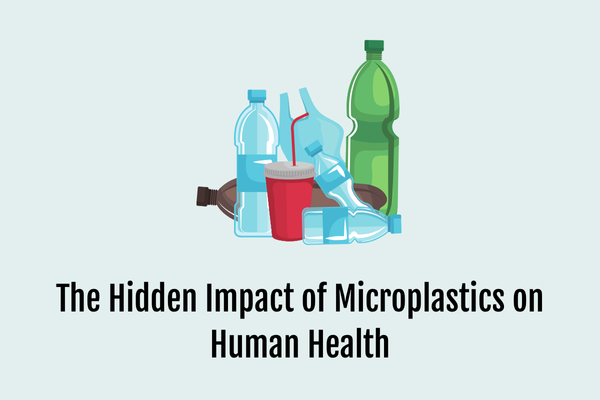The Hidden Impact of Microplastics on Human Health
Written by: Sophia Schweiger
Reviewed by: Devon Epitropoulos (Kroesche), MS, RDN, LDN
Microplastics are everywhere—and we mean everywhere. From the depths of the ocean to the water in your reusable bottle, these tiny plastic particles have made their way into our environment and, surprisingly, our diets.
So let’s break it down: What exactly are microplastics? How do they get into our food? Should we be worried? And most importantly—what can you do to protect your health through healthy eating and personalized nutrition?
This comprehensive guide will answer those questions (and more), all while weaving in practical strategies to support your wellness journey.
What Are Microplastics?
Microplastics are plastic particles less than 5 millimeters in size. Some are manufactured to be that small (called primary microplastics), like microbeads found in exfoliants or industrial products. Others are formed when larger plastics break down over time (
While they’re invisible to the naked eye, microplastics are turning up in some very unexpected places:
- Tap and bottled water
- Sea salt
- Seafood
- Honey
- Fruits and vegetables
- Air and household dust
Yes, that means you're likely consuming microplastics every day—even if you're eating clean.
How Do Microplastics Get Into Our Food?
There are several pathways through which microplastics can infiltrate our food supply:
1. Contaminated Water Supplies
Microplastics have been found in tap water and even some bottled water. This means any food you wash, boil, or prepare using that water could contain trace plastic particles.
2. Seafood Consumption
Fish and shellfish often consume microplastics present in oceans. When we eat those animals, we’re also consuming the plastic they ingested.
3. Agricultural Practices
Studies show that microplastics are present in fertilizers and irrigation water. This can lead to plastic contamination in crops—yes, even your favorite organic produce.
4. Food Packaging
Plastic containers, wraps, and even teabags can shed microplastics, especially when heated or reused. Microwaving food in plastic containers? That’s one way microplastics end up on your plate.
The Health Impact of Microplastics: What Dietitians Are Watching
While microplastics are a relatively new area of study, here’s what we know so far.
Possible Health Risks
- Hormonal disruption: Microplastics can carry endocrine-disrupting chemicals like BPA and phthalates, which may interfere with hormone regulation.
- Digestive issues: Some studies suggest that microplastics may impact gut health and the microbiome.
- Inflammation and toxicity: Long-term exposure might trigger inflammation or oxidative stress, contributing to chronic disease.
- Bioaccumulation: Toxins can accumulate in the body over time, especially if you're regularly exposed through food and air.
Although more research is needed, many nutrition professionals are already taking steps to reduce exposure in their clients' diets.
How to Limit Microplastic Exposure Through Healthy Eating
While it’s nearly impossible to avoid microplastics entirely, there are many practical, food-focused strategies that can help you reduce your exposure.
1. Prioritize Whole Foods
Ultra-processed foods are often wrapped in plastic or made using industrial methods that increase plastic exposure. Choose whole foods when possible:
- Fresh fruits and vegetables (preferably not packaged in plastic)
- Whole grains
- Lean proteins like chicken, turkey, or legumes
- Nuts and seeds (preferably stored in glass jars with metal lids—avoid metal lids with a paint coating)
Pro tip: Prioritize buying foods from farmers markets or at bulk grocery stores to avoid plastic packaging.
2. Use Glass or Stainless Steel for Storage
Avoid reheating or storing food/drink in plastic. Opt for:
- Glass meal prep containers
- Stainless steel water bottles
- Beeswax food wraps instead of plastic wrap
This is one of the easiest meal prep switches you can make.
3. Eat Lower on the Food Chain
Because of bioaccumulation, smaller organisms generally contain fewer microplastics. Eating lower on the food chain—such as plant-based meals or smaller fish—may reduce your intake.
4. Filter Your Water
If possible, invest in a high-quality water filter that’s been tested for microplastic removal. This helps cut exposure through both drinking and cooking water.
5. Focus on Gut Health
A balanced gut microbiome may help your body process and eliminate toxins more effectively. Include gut-supportive foods in your personalized nutrition plan, such as:
- Fermented foods like yogurt, kefir, and kimchi
- High-fiber foods like oats, legumes, berries, and flaxseeds
- Prebiotic-rich veggies like garlic, onions, and leeks
Meal Planning With Microplastics in Mind
Here’s how you can be proactive without overhauling your entire life:
Weekly Meal Planning Tips
- Plan meals around whole, unpackaged ingredients
- Batch cook meals and store them in glass or metal containers
- Incorporate water-rich fruits and vegetables that you’ve washed thoroughly (using filtered water if possible)
- Avoid overly processed convenience meals—these tend to come with a side of plastic exposure
Sample 1-Day Meal Plan
Breakfast
Oatmeal with chia seeds, banana, and almond butter (served in a glass bowl)
Lunch
Quinoa salad with chickpeas, roasted veggies, and olive oil vinaigrette (meal prepped in stainless steel container)
Snack
Homemade hummus with sliced carrots and cucumber (stored in mason jars)
Dinner
Grilled salmon with brown rice and steamed broccoli (cooked with filtered water)
The Role of Registered Dietitians in Tackling the Microplastic Problem
Dietitians play a key role in educating the public about environmental factors that affect our food supply. While microplastics might not be the first thing you think about when planning meals, they’re becoming an increasingly important consideration.
That’s where personalized nutrition comes in.
Why Personalized Nutrition Matters
Your exposure risk—and your body’s ability to process toxins—depends on multiple factors, including your:
- Age
- Gender
- Genetics
- Gut health
- Lifestyle
elp tailor your diet to support your unique needs. We can help you reduce unnecessary exposures while making sure your meals remain nutrient-dense, satisfying, and easy to prep.
Long-Term Strategies for a Low-Plastic Lifestyle
Looking to make sustainable changes that go beyond food? Here are a few dietitian-approved tips:
- Choose loose produce instead of pre-packaged options
- Bring your own reusable bags and containers when shopping
- Avoid single-use plastics like utensils and straws
- Support local farmers and shops that use minimal packaging
- Consider using a fabric filter for your washing machine (clothing sheds microplastics too!)
Is Eating Plastic Inevitable? What the Future Holds
While we may not be able to eliminate all microplastics from our diets today, public awareness is growing. Scientists, manufacturers, and consumers are starting to demand better packaging, cleaner water, and transparent labeling.
This issue should be approached like any other nutrition challenge—through a balanced combination of awareness, scientific understanding, and empowerment.
The Bottom Line From a Dietitian
You don’t have to live in fear of every plastic fork or water bottle—but awareness is key. By integrating small, smart changes into your meal planning and healthy eating habits, you can take proactive steps toward protecting your health.
Need help creating a personalized nutrition plan that supports your goals and minimizes unnecessary environmental exposures? Reach out to scheduling@casespecificnutrition.com to connect with a Case Specific Dietitian who can guide you through every step. Our team provides individualized nutrition care across the Greater Pittsburgh area, as well as in Erie, Raleigh, and Tampa.
The information provided in this blog is for educational purposes only and is not intended to diagnose, treat, cure, or prevent any medical condition. This content is not medical advice and should not be used as a substitute for professional medical care. If you have any health concerns or medical conditions, please consult with a qualified healthcare provider before making any changes to your diet or lifestyle.
Disclaimer: The information provided in this blog is for educational purposes only and is not intended to diagnose, treat, cure, or prevent any medical condition. This content is not medical advice and should not be used as a substitute for professional medical care. If you have any health concerns or medical conditions, please consult with a qualified healthcare provider before making any changes to your diet or lifestyle.




.png)
.webp)

